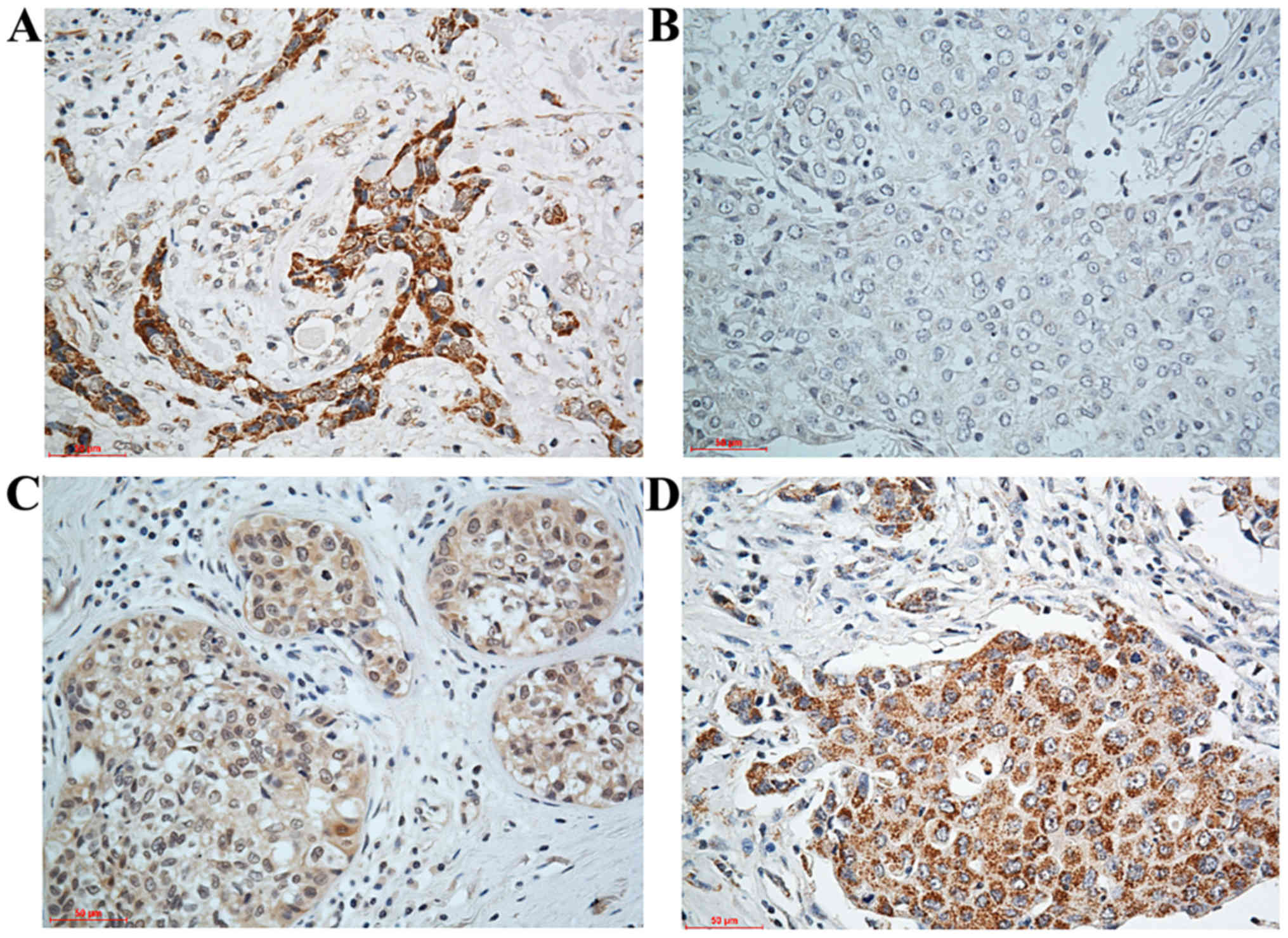|
1
|
van der Steen MJ, de Waal YR, Westermann
A, Tops B, Leenders W and Ottevanger PB: An impressive response to
pazopanib in a patient with metastatic endometrial carcinoma. Neth
J Med. 74:410–413. 2016.PubMed/NCBI
|
|
2
|
Wen J, Huang S, Rogers H, Dickinson LA,
Kohwi-Shigematsu T and Noguchi CT: SATB1 family protein expressed
during early erythroid differentiation modifies globin gene
expression. Blood. 105:3330–3339. 2005. View Article : Google Scholar : PubMed/NCBI
|
|
3
|
Yuan CL, Li L, Zhou X, Liz H and Han L:
Expression of SATB1 and HER2 in gastric cancer and its clinical
significance. Eur Rev Med Pharmacol Sci. 20:2256–2264.
2016.PubMed/NCBI
|
|
4
|
Song G, Liu K, Yang X, Mu B, Yang J, He L,
Hu X, Li Q, Zhao Y, Cai X, et al: SATB1 plays an oncogenic role in
esophageal cancer by upregulation of FN1 and PDGFRB. Oncotarget.
8:17771–17784. 2017.PubMed/NCBI
|
|
5
|
Tu W, Luo M, Wang Z, Yan W, Xia Y, Deng H,
He J, Han P and Tian D: Upregulation of SATB1 promotes tumor growth
and metastasis in liver cancer. Liver Int. 32:1064–1078. 2012.
View Article : Google Scholar : PubMed/NCBI
|
|
6
|
Zhang Y, Tian X, Ji H, Guan X, Xu W, Dong
B, Zhao M, Wei M, Ye C, Sun Y, et al: Expression of SATB1 promotes
the growth and metastasis of colorectal cancer. PLoS One.
9:e1004132014. View Article : Google Scholar : PubMed/NCBI
|
|
7
|
Fang XF, Hou ZB, Dai XZ, Chen C, Ge J,
Shen H, Li XF, Yu LK and Yuan Y: Special AT-rich sequence-binding
protein 1 promotes cell growth and metastasis in colorectal cancer.
World J Gastroenterol. 19:2331–2339. 2013. View Article : Google Scholar : PubMed/NCBI
|
|
8
|
Zhou LY, Liu F, Tong J, Chen QQ and Zhang
FW: Expression of special AT-rich sequence-binding protein mRNA and
its clinicopathological significance in non-small cell lung cancer.
Nan Fang Yi Ke Da Xue Xue Bao. 29:534–537. 2009.(In Chinese).
PubMed/NCBI
|
|
9
|
Zhao XL and Wang P: Expression of SATB1
and BRMS1 in ovarian serous adenocarcinoma and its relationship
with clinieopathological features. Sichuan Da Xue Xue Bao Yi Xue
Ban. 42(82–85): 1052011.(In Chinese).
|
|
10
|
Cheng C, Lu X, Wang G, Zheng L, Shu X, Zhu
S, Liu K, Wu K and Tong Q: Expression of SATB1 and heparanase in
gastric cancer and its relationship to clinicopathologic features.
APMIS. 118:855–863. 2010. View Article : Google Scholar : PubMed/NCBI
|
|
11
|
Alvarez JD, Yasui DH, Niida H, Joh T, Loh
DY and Kohwi-Shigematsu T: The MAR-binding protein SATB1
orchestrates temporal and spatial expression of multiple genes
during T-cell development. Genes Dev. 14:521–535. 2000.PubMed/NCBI
|
|
12
|
Heubner M, Kimmig R, Aktas B, Siffert W
and Frey UH: The haplotype of three polymorphisms in the SATB1
promoter region impacts survival in breast cancer patients. Oncol
Lett. 7:2007–2012. 2014. View Article : Google Scholar : PubMed/NCBI
|
|
13
|
Han HJ, Russo J, Kohwi Y and
Kohwi-Shigematsu T: SATB1 reprogrammes gene expression to promote
breast tumour growth and metastasis. Nature. 452:187–193. 2008.
View Article : Google Scholar : PubMed/NCBI
|
|
14
|
Zheng M, Xing W, Liu Y, Li M and Zhou H:
Tetramerization of SATB1 is essential for regulating of gene
expression. Mol Cell Biochem. 430:171–178. 2017. View Article : Google Scholar : PubMed/NCBI
|
|
15
|
Zhang S, Gao X, Ma Y, Jiang J, Dai Z, Yin
X, Min W, Hui W and Wang B: Expression and significance of SATB1 in
the development of breast cancer. Genet Mol Res. 14:3309–3317.
2015. View Article : Google Scholar : PubMed/NCBI
|
|
16
|
Jang SM, Sim J, Han H, Ahn HI, Kim H, Yi
K, Jun YJ, Rehman A, Chung MS, Jang K, et al: Clinicopathological
significance of CADM4 expression in invasive ductal carcinoma of
the breast. J Clin Pathol. 66:681–686. 2013. View Article : Google Scholar : PubMed/NCBI
|
|
17
|
Kim S, Lee J, Jeon M, Nam SJ and Lee JE:
Elevated TGF-β1 and -β2 expression accelerates the epithelial to
mesenchymal transition in triple-negative breast cancer cells.
Cytokine. 75:151–158. 2015. View Article : Google Scholar : PubMed/NCBI
|
|
18
|
Kim S, Lee J, Oh SJ, Nam SJ and Lee JE:
Differential effect of EGFR inhibitors on tamoxifen-resistant
breast cancer cells. Oncol Rep. 34:1613–1619. 2015. View Article : Google Scholar : PubMed/NCBI
|
|
19
|
Yu Z, Sun M, Jin F, Xiao Q, He M, Wu H,
Ren J, Zhao L, Zhao H, Yao W, et al: Combined expression of ezrin
and E-cadherin is associated with lymph node metastasis and poor
prognosis in breast cancer. Oncol Rep. 34:165–174. 2015. View Article : Google Scholar : PubMed/NCBI
|















